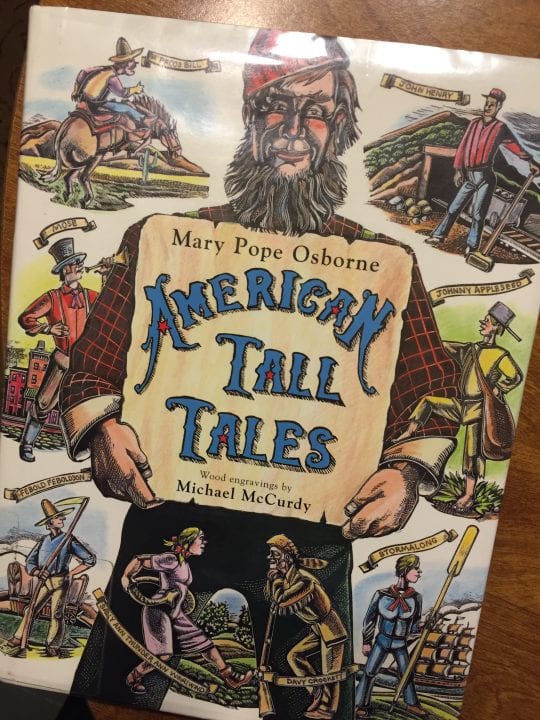
WITS Voices: Tall Tales for Short Writers
December 17, 2015
By Karen Finneyfrock, WITS Writer-in-Residence
In researching lesson ideas for a new WITS residency focused on tall tales, I Googled, “exaggeration for kids.” The top hits all advertised tips on getting your child to stop exaggerating. What better indication that tall tales would be perfect stories for fourth graders? Kids love to exaggerate!
Tall tales are uniquely American stories that feature a larger-than-life main character in an exaggerated but real setting who solves a problem in a humorous or surprising way. Exaggeration is the major element in tall tales.
Since I teach at the western edge of the continental US, I started students with lumberjack Paul Bunyan and his companion Babe, the blue ox, one of the only classic tall tale characters to make it so far west. The kids were rapt. When Paul discovers that the Big Onion River is too windy for him to send down his logs, he ties one end of his rope to the river and the other end to Babe. Then he yells, “Pull!” Babe pulls until the river is straight. Fourth graders giggle with delight and mutter, “That’s impossible.”
They enjoyed other classic tall tales like John Henry, Febold Feboldson and Stormalong. There isn’t a lot of diversity in the classic tall tales, so I added newer stories to my syallabus, like Sally Ann Thunder Ann Whirlwind by Mary Pope Osborne and Dona Flor by Pat Mora.
Then, it was time for students to write their own tall tales. I started them off with exaggeration practices, allowing them to fill in blanks like this one:
The baby was huge. For breakfast, he ate ___________________.
Next, we moved on to setting. Since tall tales feature real but exaggerated settings, I asked all of the students to set their stories in the town where they live, Port Townsend, WA. This led to lines like,
“Port Townsend-a town where there are as many deer as the stars in the night’s sky and as many trees as the words in a dictionary.” –Henri H.
The following day we invented our characters. To name them, we did a sort of group Mad Lib. I asked students for common first names, objects and natural events. I filled them into blanks and we ended up with character names like: Liza Tsunami, Chasin Hurricane, Eddie Honkey-tonk, Trevor Saw Horse and Misty Tornado. Character brainstorming led to lines like this one:
“The baby had eyes as grey as tornados, as if you could see thoughts going through his head.” –Malachi M.
After creating our characters and their special abilities, students decided on the problem each would face. Inspired by the challenges our tall tale heroes encountered, students invented problems like, “a bear tries to steal one of her pies,” or, “an orca whale is swimming away with his iceberg.” I made sure to remind students not to solve their problems using violence and to find surprising solutions.
With that brainstorming done, we were finally ready to put it all together and write our own tall tales.
Suggested Texts:
American Tall Tales by Mary Pope Osborne
Dona Flor by Pat Mora
Karen Finneyfrock is a poet and novelist. She is the author of two young adult novels: The Sweet Revenge of Celia Door and Starbird Murphy and the World Outside, both published by Viking Children’s Books. She is one of the editors of the anthology Courage: Daring Poems for Gutsy Girls and the author of Ceremony for the Choking Ghost, both released on Write Bloody press. She is a former Writer-in-Residence at Richard Hugo House.
WITS Voices features posts by SAL’s WITS Writers-in-Residence, our core of professional, local writers, who share their experiences working with K-12 students. Through our Writers in the Schools Program, WITS Writers teach creative writing in public school classrooms throughout the Seattle, Highline, Port Townsend and Shoreline Districts, as well as at Seattle Children’s Hospital.